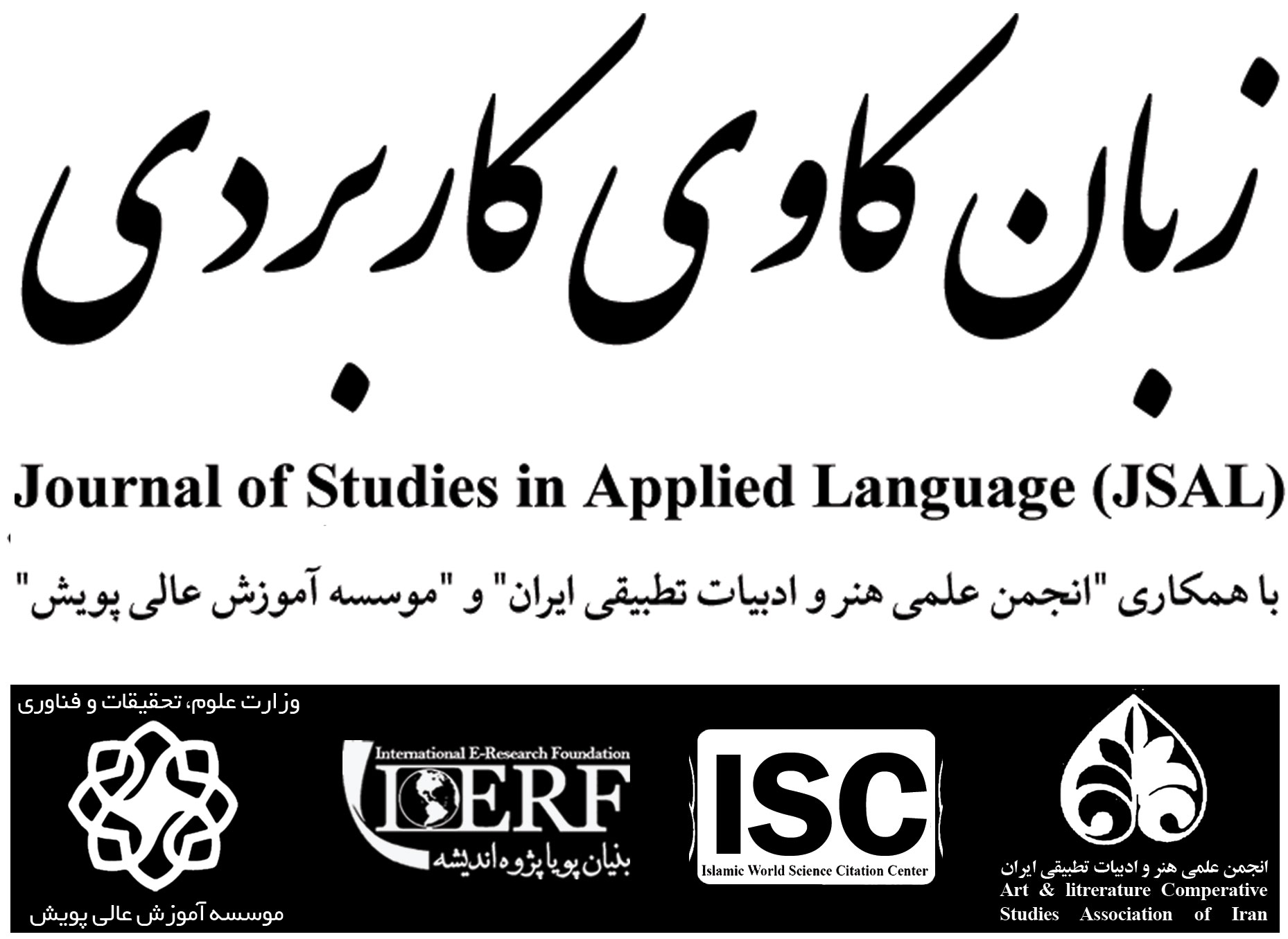Volume 7, Issue 3 (Journal of Studies in Applied Language (JSAL) 2024)
JSAL 2024, 7(3): 1-24 |
Back to browse issues page
Download citation:
BibTeX | RIS | EndNote | Medlars | ProCite | Reference Manager | RefWorks
Send citation to:



BibTeX | RIS | EndNote | Medlars | ProCite | Reference Manager | RefWorks
Send citation to:
ghaderi A, Mohammadi R. (2024). A Semiotic Exploration of Poetic Discourse: An Analysis of “Madinat al-Sandbad” [In Arabic]. JSAL. 7(3), 1-24.
URL: http://jsal.ierf.ir/article-1-130-en.html
URL: http://jsal.ierf.ir/article-1-130-en.html
1- Assistant Professor, Department of Arabic Language and Literature, Faculty of Arts and Humanities, Shahid Bahonar University of Kerman, Kerman, Iran , a.ghaderi@uk.ac.ir
2- Assistant Professor, Department of Arabic Language and Literature, Faculty of Arts and Humanities, Vali-e Asr University - Rafsanjan, Kerman, Iran
2- Assistant Professor, Department of Arabic Language and Literature, Faculty of Arts and Humanities, Vali-e Asr University - Rafsanjan, Kerman, Iran
Abstract: (476 Views)
The semiotic approach to literature entails deciphering a literary work through its embedded signs, wherein the language of poetry constructs a sign system, with each sign comprising an indivisible duality: the signifier and the signified. This analytical framework originates from the intellectual contributions of figures such as Charles Sanders Peirce, an American philosopher, and Ferdinand de Saussure, a Swiss linguist. Semiotic linguistic studies endeavor to dissect and fathom the multifaceted layers of language, unearthing the latent content within. These studies delve into the dynamics between signifiers and signifieds as they manifest across diverse sign systems. The current analysis scrutinizes Badr Shakir al-Sayyab's poem “Madinat al-Sandbad” through a semiotic lens, concentrating on its title, musicality, language, and structure. The objective is to elucidate the signifiers and signifieds within the poem, thereby exposing the underlying social and political nuances concealed within its innovative poetic framework. The poet employs a repertoire of signs to communicate with the reader, signs that transcend their literal interpretations and imbue the text with novel significance. Interpretive analysis allows for the identification of signs at various levels, including the title, sound, word choice, and structure. The semiotic examination of the title suggests that the poem metaphorically references Baghdad, employing ambiguous language to evade the scrutiny of authorities. Through an exploratory reading, the reader can glean insights into the societal milieu of al-Sayyab's era from the poem's overt discourse, replete with themes of sorrow, despair, and hopelessness, despite occasional semantic dissonance within certain phrases. The linguistic elements of the poem serve as a unique set of signs that subtly convey meaning. On a grammatical level, the signs within sentences and phrases diverge from their conventional meanings, a phenomenon facilitated by the axes of substitution and addition, which collectively articulate the text's intrinsic meaning. Through interpretive reading, which relies on signs and scrutinizes syntactic and rhetorical constructs, the myths and symbols encountered in exploratory reading contribute to the generation of semantic associations and intricacies within the text, ultimately captivating the reader's attention with profound meanings and signs.
Type of Study: Research |
Subject:
Linguistic research
Received: 2024/05/6 | Accepted: 2024/08/22 | Published: 2024/09/14
Received: 2024/05/6 | Accepted: 2024/08/22 | Published: 2024/09/14
References
1. Abbas, I., (1998). Characteristics of letters and meanings, Damascus: Al-Asad Al-Wataniyyat Library. [In Arabic]
2. Abdulmutallib, M., (1995). Bena al-Oslob fi Sharh al-Hedasa, Cairo: Dar al-Ma'arif Publications. [In Arabic]
3. Abdulmutallib, M., (1995). The Dialectic of Individuals and Combinations, 2th edition, Cairo: Al-Masriyya Al-Alamiya Publishing Company. [In Arabic]
4. Abid, M., (2001). Al-Qasidah al-Arabiyyah hadith between al-Buniyah al-Dalaliyah and al-Buniyah al-Iqaaiyah, Damascus: Etihad of the Book of the Arabs. [In Arabic]
5. Ahmad Nahle, M., (2001). Al-Nazami Linguistics (Introduction to Halliday's Linguistic Theory), 2th edition, Cairo: Mutalaqi al-Fekr Publications. [In Arabic]
6. Al-Abta, M., (1970). Azva on poem and life of Badr al-Shaker al-Sayyab, 1th edition, Baghdad: Dar al-Salam Publications. [In Arabic]
7. Al-Marabet, A., (2010). Al-Simiya Al-Amaa and Simiya Al-Adab, 1th edition, Lebanon: Al-Dar Al-Arabiya Lul-Uloom Publishers. [In Arabic]
8. Al-Raihani, M., (1998). Attijahat in temporal analysis in linguistic studies, Cairo: Dar Quba Publications. [In Arabic]
9. Al-Sayyab, B., (1981). Onshudah al-Matar, 3th edition, Beirut: Dar al-Oudah Publications. [In Arabic]
10. Anis, I., (1952). Music of poetry, 2th edition, Cairo: Maktaba al-Anjelo al-Mesriat Publications. [In Arabic]
11. Ashri Zayed, A., (1997). Invoking the historical figures in contemporary Arabic poetry, Cairo: Dar al-Fekr al-Arabi Publications.
12. Atiq, A., (2009). Elm al-Ma'ani, Beirut: Dar al-Nahda al-Arabiya Publications. [In Arabic]
13. De Sir Lo, J., (2010). The Culture of Symbols, translated by: Mehrani Ohadi, 1th edition, Tehran: Dostan Publishing House. [In Persian]
14. Dinah Sen, A., (2010). An Introduction to Bershnehology, translated by: Mozaffar Qahraman, Tehran: Parestesh Publishing House. [In Persian]
15. Fazl, S., (1998). Semiological study in the poetry of al-Qas and al-Qasid., Al-Jizah: Ain for humanitarian and social studies and research. [In Arabic]
16. Gendler, D., (2007). Fundamentals of semiotics, translated by Mehdi Parsa, 2th edition, Tehran: Surah Mehr Publications.
17. Giro, B., (1998). The science of signaling, translated by: Manzer Ayashi, Damascus: Dar Talas Publications. [In Arabic]
18. Ibn Manzoor, M., (1993). Lesan al-Arab, 3th edition, Damascus: Dar Sadir Publications . [In Arabic]
19. Khalaf Kamel, E., (2003). Al-Tijah al-Simology and poetry criticism, Egypt: Dar al-Farha Publications. [In Arabic]
20. Maoush, S., (2006). Badr al-Shaker al-Sayyab, 1th edition, Beirut: Bejson Institute. [In Arabic]
21. McQueen, J., (1993). Al-Musoaah al-Mostala al-Annagdi, translated by: Abd al-Wahed al-Lalluah, 1th edition, Beirut. [In Arabic]
22. Meftah, M., (1992). Analyzing the poetic speech, 2th edition, Beirut: Al-Marqas Al-Arabi Publications. [In Arabic]
23. Shovali, J., (2007). A Dictionary of Symbols, translated by Soudabeh Fazaeil, 1th edition, Tehran: Jihoun Publishing House. [In Persian]
24. Mousavi S M. (2021). Canonizing Shahnameh in Early Modern Iran: A Historical-Semiotic Approach [In English]. JSAL. 4(2), 183-200.
25. Waiss, M.,(2005). Al-Enziah men Manzoor al-Derasat al-Uslobiya, 1th edition, Beirut: Majd Press Publications. [In Arabic]
Send email to the article author
| Rights and permissions | |
 |
This work is licensed under a Creative Commons Attribution-NonCommercial 4.0 International License. |








